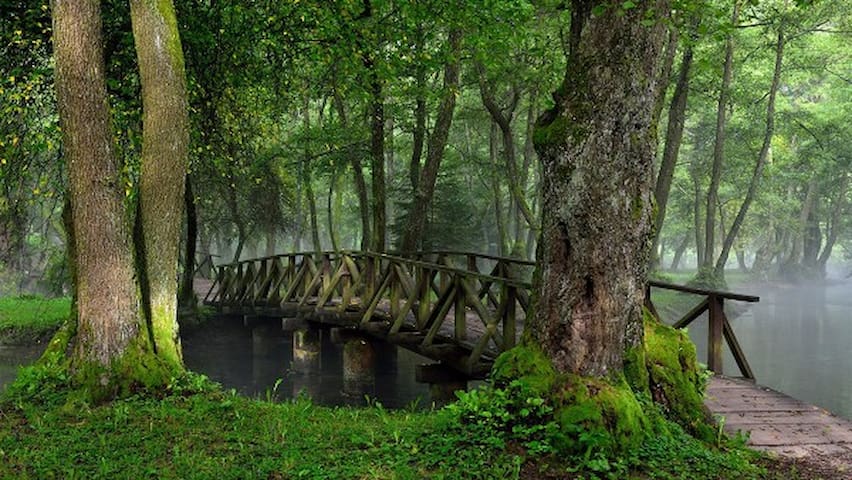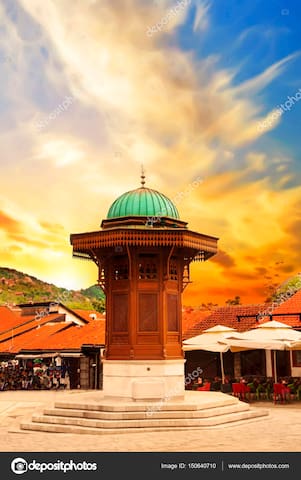Neighborhoods
Baščaršija is the old part of Sarajevo and during the Ottoman period it was the main artery of the city – the main trading area and an epicenter for nearly all of the important social goings-on.
Baščaršija still has two old covered bazaars, known as Gazi Husrev Bey's Bezistan and Brusa Bezistan, then there’s Gazi Hurev Bey's Mosque, Medresa and Library; Sahat Kula (Clock Tower), the workshops of Sarajevo's famous artisans, Morića Han (inn) and Kolobara Han....
Baščaršija is also the gastronomical center of Sarajevo because it's here in this part of town that you'll find the most popular aščinicas, buregdžinicas, ćevabdžinicas....
A must-see destination for all visitors is the famous Baščaršija Square and Sebilj – one of the most impressive symbols of Sarajevo.
310 personas locales recomiendan
Baščaršija
Baščaršija is the old part of Sarajevo and during the Ottoman period it was the main artery of the city – the main trading area and an epicenter for nearly all of the important social goings-on.
Baščaršija still has two old covered bazaars, known as Gazi Husrev Bey's Bezistan and Brusa Bezistan, then there’s Gazi Hurev Bey's Mosque, Medresa and Library; Sahat Kula (Clock Tower), the workshops of Sarajevo's famous artisans, Morića Han (inn) and Kolobara Han....
Baščaršija is also the gastronomical center of Sarajevo because it's here in this part of town that you'll find the most popular aščinicas, buregdžinicas, ćevabdžinicas....
A must-see destination for all visitors is the famous Baščaršija Square and Sebilj – one of the most impressive symbols of Sarajevo.
Sightseeing
Museum of the Jews of Bosnia and Herzegovina
Velika avlija Laure Papo BahoreteGazi Husrev-beg Mosque
8 SaračiOld Orthodox Church
59 Mula Mustafe BašeskijeSacred Heart Cathedral
2 Trg Fra Grge MartićaVrelo Bosne
Gazi Husrev-beg's Bezistan
Gazi Husrev-begovaWar Childhood Museum
Sebilj
1 BaščaršijaIf you enjoy nature and hiking this is the right place for you.
73 personas locales recomiendan
Skakavac Waterfall
If you enjoy nature and hiking this is the right place for you.
Only 10 minutes by cable car from Sarajevo, a true oasis of peace, richness of nature and an air spa just above Sarajevo. It has a beautiful view of the city and is full of amenities for both: solo travelers and families with children.
85 personas locales recomiendan
Trebević
Only 10 minutes by cable car from Sarajevo, a true oasis of peace, richness of nature and an air spa just above Sarajevo. It has a beautiful view of the city and is full of amenities for both: solo travelers and families with children.
Museums
Sarajevo Museum 1878-1918
This dependency houses the permanent exhibition of Sarajevo from 1878 to 1918, displaying Sarajevo during the Austro-Hungarian period.
This chronological and thematic exhibition begins with a presentation of the events preceding the Berlin Congress when Austria-Hungary was given a mandate to administer Bosnia and Herzegovina, and concludes with World War I and the part played in it by the First Bosnian Regiment. The themes of the exhibition are: 1. Resistance to the occupation; 2. The new administration; 3. Lifestyle; 4. Cultural, religious and educational societies, printing presses and publishing; 5. Industry and architecture; 6. The annexation and the Bosnian Assembly; 7. The assassination of the heir presumptive, Archduke Franz Ferdinand, and his wife Sophie; 8. World War I. The exhibition also includes life-size models of Franz Ferdinand and Sophie. The Museum of Sarajevo 1878-1918 is located in the actual building outside which Archduke Franz Ferdinand and Sophie were assassinated. The Austro-Hungarian period in Bosnia and Herzegovina saw the introduction of a new, modern system of administration, industrialization, and new road and rail communications. The new architecture brought Bosnia into the family of Central European states, and made Sarajevo a city that kept pace architecturally with Prague and Vienna. Despite the economic development resulting from industrialization, traditional crafts were preserved, by the establishment of arts and crafts workshops. The first electric power plants were built and electricity was introduced to the city. New fashions were also introduced, combining with the traditional way of life to create a new lifestyle. Civil society began to emerge with the establishment of associations of various kinds: choral societies, temperance societies, automobile associations, women’s associations and so on. By 1904, women were already driving cars. The development of publishing and new printing presses, accompanied by advances in education and literacy, helped to create the consciousness of nationhood among all three peoples (Serbs, Croats and Bosniacs). All these events and changes during the Austro-Hungarian period, presented museologically, can be seen by visitors to the Museum. This kind of presentation of historic events makes it easier to understand them, by revealing them in a different light.
81 personas locales recomiendan
Sarajevo Museum 1878 – 1918
1 Zelenih beretkiSarajevo Museum 1878-1918
This dependency houses the permanent exhibition of Sarajevo from 1878 to 1918, displaying Sarajevo during the Austro-Hungarian period.
This chronological and thematic exhibition begins with a presentation of the events preceding the Berlin Congress when Austria-Hungary was given a mandate to administer Bosnia and Herzegovina, and concludes with World War I and the part played in it by the First Bosnian Regiment. The themes of the exhibition are: 1. Resistance to the occupation; 2. The new administration; 3. Lifestyle; 4. Cultural, religious and educational societies, printing presses and publishing; 5. Industry and architecture; 6. The annexation and the Bosnian Assembly; 7. The assassination of the heir presumptive, Archduke Franz Ferdinand, and his wife Sophie; 8. World War I. The exhibition also includes life-size models of Franz Ferdinand and Sophie. The Museum of Sarajevo 1878-1918 is located in the actual building outside which Archduke Franz Ferdinand and Sophie were assassinated. The Austro-Hungarian period in Bosnia and Herzegovina saw the introduction of a new, modern system of administration, industrialization, and new road and rail communications. The new architecture brought Bosnia into the family of Central European states, and made Sarajevo a city that kept pace architecturally with Prague and Vienna. Despite the economic development resulting from industrialization, traditional crafts were preserved, by the establishment of arts and crafts workshops. The first electric power plants were built and electricity was introduced to the city. New fashions were also introduced, combining with the traditional way of life to create a new lifestyle. Civil society began to emerge with the establishment of associations of various kinds: choral societies, temperance societies, automobile associations, women’s associations and so on. By 1904, women were already driving cars. The development of publishing and new printing presses, accompanied by advances in education and literacy, helped to create the consciousness of nationhood among all three peoples (Serbs, Croats and Bosniacs). All these events and changes during the Austro-Hungarian period, presented museologically, can be seen by visitors to the Museum. This kind of presentation of historic events makes it easier to understand them, by revealing them in a different light.
Razgledavanje
Ferhadija
FerhadijaShopping
Sarajevo City Center
1 VrbanjaBBI Center
1 Trg djece SarajevaAlta Shopping Center
2 Franca LeharaCofee and sweets
Rahatlook is interesting name which pronounced in a Bosnian accent actually means happy-go-lucky in English. It’s a place where you can enjoy casual coffee with homemade desserts. Rahatlook is situated in the old part of town, just a passage away from the main pedestrian street Ferhadija and the apartment. Its just 20 sec from the apartment.
17 personas locales recomiendan
Rahatlook
41 FerhadijaRahatlook is interesting name which pronounced in a Bosnian accent actually means happy-go-lucky in English. It’s a place where you can enjoy casual coffee with homemade desserts. Rahatlook is situated in the old part of town, just a passage away from the main pedestrian street Ferhadija and the apartment. Its just 20 sec from the apartment.



